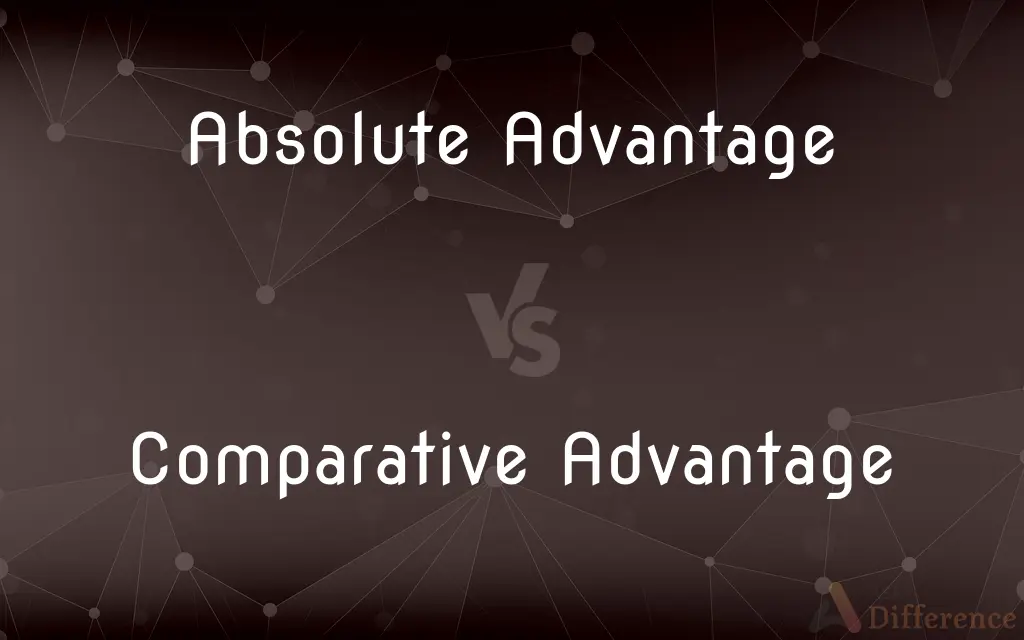Absolute Advantage vs. Comparative Advantage — What's the Difference?
Edited by Tayyaba Rehman — By Fiza Rafique — Published on December 11, 2023
Absolute Advantage is about producing more with the same resources, while Comparative Advantage focuses on producing at a lower opportunity cost.

Difference Between Absolute Advantage and Comparative Advantage
Table of Contents
ADVERTISEMENT
Key Differences
Absolute Advantage exists when one entity can produce a good more efficiently than another, using the same quantity of resources. Conversely, Comparative Advantage arises when an entity can produce a good at a lower opportunity cost than another.
In the realm of Absolute Advantage, the emphasis is on sheer productivity. If Country A can produce more wheat than Country B using the same amount of labor, then Country A has an Absolute Advantage in wheat production. In contrast, Comparative Advantage emphasizes relative efficiency. Even if Country B is less productive in all goods, it might still have a Comparative Advantage in one if its opportunity cost is lower.
It's possible for a country or business to have an Absolute Advantage in multiple goods or services. However, according to economic theories, it's impossible for an entity to have a Comparative Advantage in everything. This is because Comparative Advantage is based on relative opportunity costs.
Trade theories suggest that countries benefit most when they focus on goods in which they have a Comparative Advantage, rather than those in which they have an Absolute Advantage. This is because Comparative Advantage highlights the underlying opportunity costs and potential gains from trade.
While Absolute Advantage provides a straightforward measure of productivity, Comparative Advantage offers a deeper insight into the potential benefits of specialization and trade between entities, be they countries or businesses.
ADVERTISEMENT
Comparison Chart
Basis of Advantage
Quantity of output with same resources
Lower opportunity cost
Trade Implication
Not a strong basis for trade
Underlies gains from trade and specialization
Possibility for Multiple Goods
Possible in multiple goods
Not possible in all goods simultaneously
Measuring Efficiency
Efficiency in production
Efficiency in terms of opportunity costs
Real-World Application
Less common in trade theories
Widely recognized in international trade theory
Compare with Definitions
Absolute Advantage
The ability to produce more of a good using the same resources.
The USA has an Absolute Advantage in airplane manufacturing because it can produce more planes than Brazil with the same number of workers.
Comparative Advantage
A relative efficiency in producing a particular good.
Due to its climate and soil, Chile has a Comparative Advantage in grape growing.
Absolute Advantage
Dominance in efficient production of a good or service.
With its skilled labor, Italy holds an Absolute Advantage in luxury car manufacturing.
Comparative Advantage
Production driven by the lowest relative sacrifice.
Mexico's Comparative Advantage in textiles reflects where they've sacrificed the least in terms of other possible goods.
Absolute Advantage
A clear productivity edge over another producer.
Due to vast fertile lands, Argentina has an Absolute Advantage in beef production.
Comparative Advantage
Specializing in goods with the lowest cost in terms of other goods.
India's Comparative Advantage in IT services stems from trading off other industries.
Absolute Advantage
Superior production efficiency in comparison to another.
With advanced technology, France has an Absolute Advantage in wine production.
Comparative Advantage
Where one's production has the least cost in forgone alternatives.
Although Japan produces many goods, its Comparative Advantage might lie in technology due to the lower opportunity costs.
Absolute Advantage
Greater output with equal input.
China's Absolute Advantage in toy production enables them to dominate the market.
Comparative Advantage
Producing a good at a lower opportunity cost.
Even if less efficient overall, Vietnam might have a Comparative Advantage in rice farming if its opportunity costs are lower.
Common Curiosities
Why is Comparative Advantage important for trade?
Comparative Advantage underscores potential benefits from specialization and trade, even if one entity has an Absolute Advantage in all goods.
How is Absolute Advantage determined?
Absolute Advantage is determined by comparing raw productivity levels between producers.
Can a country without an Absolute Advantage still benefit from trade?
Yes, a country can benefit from trade by leveraging its Comparative Advantage even without an Absolute Advantage.
Is it possible for a country to have an Absolute Advantage but not a Comparative Advantage in a good?
Yes, a country might have an Absolute Advantage (produce more) but might have a higher opportunity cost, lacking a Comparative Advantage.
Why might two countries trade even if one has an Absolute Advantage in all goods?
They'll trade based on Comparative Advantage, where relative opportunity costs create potential mutual benefits.
What's the main difference between Absolute and Comparative Advantage?
Absolute Advantage relates to sheer productivity, while Comparative Advantage emphasizes lower opportunity costs.
Does Absolute Advantage always result in trade benefits?
Not necessarily. Trade benefits are more closely aligned with Comparative Advantage than Absolute Advantage.
Can one country have Comparative Advantage in all goods?
No, a country cannot have a Comparative Advantage in all goods due to the principle of opportunity cost.
How do resources affect Absolute Advantage?
Abundance or efficiency of resources can confer an Absolute Advantage in production to a country or firm.
Can a firm or individual have Absolute or Comparative Advantage?
Yes, both concepts apply to countries, firms, or individuals when discussing production efficiencies.
How do changing opportunity costs affect Comparative Advantage?
As opportunity costs change, the Comparative Advantage of countries may shift, influencing trade dynamics.
How do opportunity costs relate to Comparative Advantage?
Comparative Advantage is directly tied to opportunity costs; a producer with lower opportunity costs for a good has a Comparative Advantage in it.
Can a country's policies influence its Absolute or Comparative Advantage?
Yes, policies like subsidies, tariffs, and education can shape both Absolute and Comparative Advantage.
Why is Comparative Advantage a foundational concept in international trade theory?
Comparative Advantage illustrates how countries can benefit from specialization and trade, maximizing global output.
Can technology give a country an Absolute Advantage?
Yes, superior technology can grant a country an Absolute Advantage in producing certain goods.
Share Your Discovery

Previous Comparison
Alexa vs. SiriAuthor Spotlight
Written by
Fiza RafiqueFiza Rafique is a skilled content writer at AskDifference.com, where she meticulously refines and enhances written pieces. Drawing from her vast editorial expertise, Fiza ensures clarity, accuracy, and precision in every article. Passionate about language, she continually seeks to elevate the quality of content for readers worldwide.
Edited by
Tayyaba RehmanTayyaba Rehman is a distinguished writer, currently serving as a primary contributor to askdifference.com. As a researcher in semantics and etymology, Tayyaba's passion for the complexity of languages and their distinctions has found a perfect home on the platform. Tayyaba delves into the intricacies of language, distinguishing between commonly confused words and phrases, thereby providing clarity for readers worldwide.













































